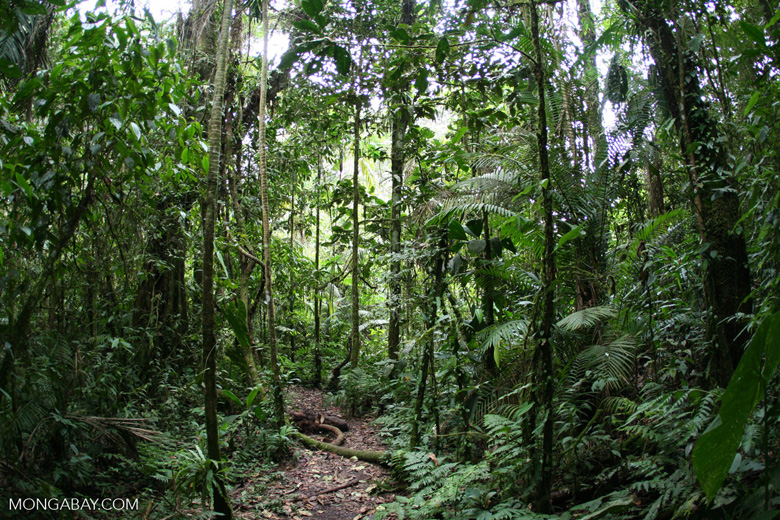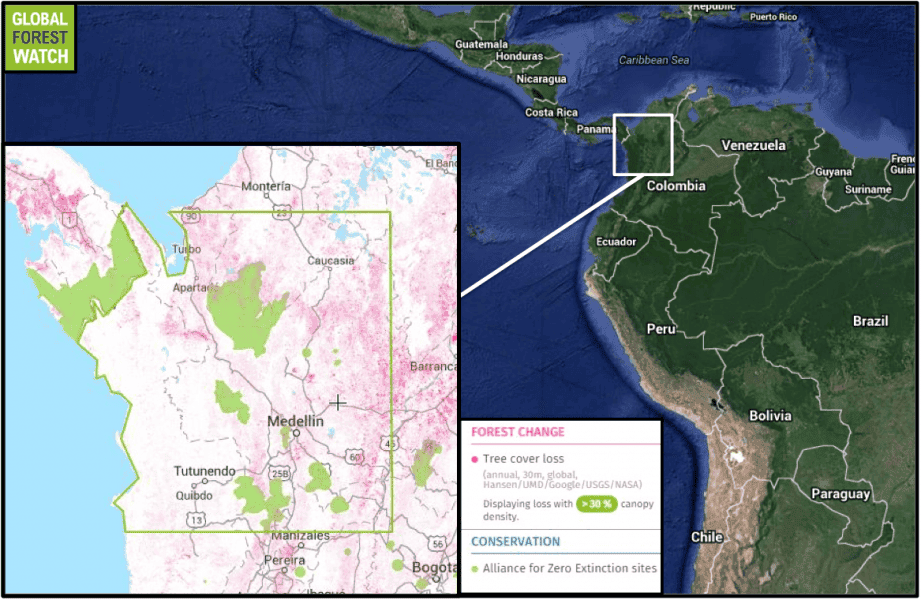- Over the last decade, tropical forests in northwestern Colombia have been shrinking and shifting directionally likely due to changing climatic conditions.
- The researchers warn this may spell doom for species with isolated ranges and nowhere else to go.
- The study’s findings are probably not isolated to South America, and that tropical forests around the world are shifting in response to climate change.
It’s well known that climate change is significantly affecting the world’s oceans as sea level rise and water acidifies. But forests are also experiencing big impacts. Shifting precipitation patterns are bringing droughts to the Amazon rainforest, and warmer winter temperatures are allowing tree-killing beetles to spread farther north in boreal regions. Now, new research finds that climate change may be making tropical forests “move.”
A study published recently in the Proceedings of the National Academy of Sciences found that over the last decade, tropical forests in north-western Colombia have been shrinking and changing directionally with time as a likely response to climate change. Areas in the northern Andean montane forests and adjacent lowlands of Colombia are experiencing a phenomenon called “thermophilization,” the study says, meaning that the abundance of cold-tolerating highland species is decreasing while only heat-loving, lowland tree species are being left behind. These patterns are consistent with the expectations of upwards species migrations due to climate change, the authors write.
The study found strong links between tree species composition and temperature changes. On the surface, the changes to these forests seem deceptively small, Kenneth Feeley, co-author of the PNAS study and Assistant Professor of Biology at Florida International University, told mongabay.com. “If you were to go to the forest every year and look around, you would see lots of green, healthy vegetation,” he said. “It is only with precise measurements of which species are there, how many of each species is there, and how big each tree is, that the changes are revealed. Once you see the numbers, you realize that the changes are huge.”

Feeley said that some species’ ranges are shifting upwards by an average of two to three meters every year, which equates to a horizontal shift of tens of meters. He attributes most of this change due to dieback at the lower altitudes of their distributions.
“So if you stood at the bottom range of species one year, then returned ten years later, the lowest individual of that species would now be somewhere like 20 meters above you or maybe about 100 meters away,” Feeley said.
In other words, instead of the distributions of tree communities shifting or expanding, they are retreating upwards as it gets too hot for them in lower portions of their ranges. This, the authors say, does not bode well for species persistence or biodiversity.
This study, conducted in Antioquia, Colombia, follows two previous studies; one conducted in Manu National Park, Peru, and the other in Volcan Barva, Costa Rica. “Taken together, the three studies all suggest that widespread upwards species migrations may be occurring throughout many neotropical montane forests,” the authors write.
Feeley says the effects seem to be ubiquitous within these areas studied.
“The relative abundance of lowland species is increasing,” Feeley said. “But this is only because there has been a decrease in the abundance of highland species. The general pattern is that species are dying back from the low, hot portions of their range but they are failing to expand their ranges into the newly-suitable habitats at higher elevations. Over just a decade, the species richness of adult trees decreased in 15 of the 16 study plots in Colombia by an average of four species,” he said.
“In theory, we would expect that species should also invade into higher elevations into the areas that used to be too cold for them but that are now ‘just right’. But in most cases, species are not invading the higher elevations,” Feeley added. This, he said, could be due to a lack of dispersal or several other factors that prevent species from establishing in new areas.

The researchers found that, for adult trees, communities with more mammal, bird or wind-dispersed seeds are changing faster in their composition compared to communities with more ant, water, gravity and ballistic dispersal.
From a conservation point of view, this is important because, “we are simultaneously decreasing the abundance of mammal and bird species and fragmenting habitat in these landscapes,” the authors write.
In the case of juvenile trees, compositional changes are associated more strongly with soil conditions that can influence germination and establishment. The researchers found that juvenile tree communities are changing more quickly than adult communities. Feeley said that this is because juvenile tree communities are more dynamic than adult communities. Individuals die and recruit at faster rates, meaning that you can see faster rates of change in composition through time, he said. Adult communities have a lot of momentum; they have big, old trees that tend to stick around even when the climate is no longer right for them.

Other environmental factors such as species-soil adaptations, as well as anthropogenic disturbances like hunting and habitat loss may limit wildlife migrations and consequently decrease the ability of forest communities to respond to climate change, the study points out.
Thermophilization is occurring in trees at rates consistent with concurrent temperature increases, the study found. The findings support the hypothesis that these observed compositional changes are part of a long-term process, such a global warming, and are not a response to any single episodic event. The results all indicate that tropical forests are being strongly affected by climate change and suggest that many species will be at an elevated risk of extinction as warming continues.
Since the 1960s, mean annual temperatures in the province of Antioquia, Colombia, have been increasing. The rate of warming throughout the Neotropics is accelerating and temperatures are expected to increase by two to four degrees Celsius by the end of this century.
Researchers say it is important to keep in mind that climate change involves many variables other than just mean annual temperature. For example, changes in the timing or amount of precipitation can potentially drive species migrations as well. “In other words, the thermophilization of the north Andean tree communities may have the adverse effect of making these forests more moisture-demanding and susceptible to future drought,” the study says. That is bad news for the persistence of these systems because most climate models predict decreasing rainfall, especially over dry season periods, in this region over the coming decades. Changes in the juvenile tree communities also indicate that these forests will continue to undergo compositional shifts long into the future.
Tropical forests are systematically underrepresented in studies examining the effects of climate change, Feeley said. “We tend to focus our attention on systems such as the Arctic or Antarctic where changes are easily visible in the form of melting ice or rising sea levels. But in reality, some of the strongest and most dire effects of climate change are likely to be in the tropical forests,” he said.

Often considered the hottest of all biodiversity hotspots, according to Feeley, the Andes Mountain region is one of the most biologically diverse and threatened regions of the world. Most Andean species have small ranges and many are restricted to narrow elevation bands or even to single valleys or ridges.
“The Andes Mountains contain huge numbers of endemic species which are inherently more sensitive to changes in their environment than widespread generalist species,” Feeley said.
According to the Alliance for Zero Extinction, the study site is home to a number of endangered species like the chestnut-capped piha (Lipaugus weberi) and the chestnut-bellied flowerpiercer (Diglossa gloriosissima), both birds that are native to Colombia. Among the critically endangered species are amphibians like the Antado stubfoot toad (Atelopus galactogaster) that is known only from 10 specimens, the Niceforo’s stubfoot toad (Atelopus nicefori), and the Argelia robber frog (Pristimantis bernali), which occupies an area less than 10 square kilometres (four square miles) in size. Handley’s slender mouse opossum (Marmops handleyi) is another critically endangered species, known only from two individuals that were found within the Antioquia study site.

“If tree species are dying back, then the animals that depend on them will inevitably dieback as well,” Feeley said. Indeed, a previous study in Peru showed that bird species are changing their distributions at about the same rates as the tree species.
Many of the thousands of species supported by tropical forests are specialized and adapted to highly stable climates and are therefore very sensitive to changes in climate that we are now causing, Feeley said.
The fact that results from all three independent studies conducted in different parts of the Neotropics are all so consistent between different forests has two big implications: that the driver of these compositional shifts is global warming, and that they are likely occurring in other tropical forests around the world.
“The effects of climate change are ubiquitous and pervasive – they cannot be escaped and they care little about isolation or protection,” Feeley said.
According to the study, high rates of deforestation and loss of wildlife in the study area will likely further decrease forest connectivity and diminish many plant species’ ability to reach new suitable areas in the future.
“Reduced connectivity coupled with accelerating climate change (including both increases in temperatures and reductions in water availability) will result in faster range retractions and may increase the likelihood of local and global extinctions,” the authors write.
But knowing how forests are shifting may help conservationists prepare for a changing world.
“Understanding how species respond to climate change is crucial to the development of effective conservation strategies,” write the authors.
Citations:
- Feeley, K. J., Hurtado, J., Saatchi, S., Silman, M. R., & Clark, D. B. (2013). Compositional shifts in Costa Rican forests due to climate‐driven species migrations. Global change biology, 19(11), 3472-3480.
- Feeley, K. J., Silman, M. R., Bush, M. B., Farfan, W., Cabrera, K. G., Malhi, Y., … & Saatchi, S. (2011). Upslope migration of Andean trees. Journal of Biogeography, 38(4), 783-791.













